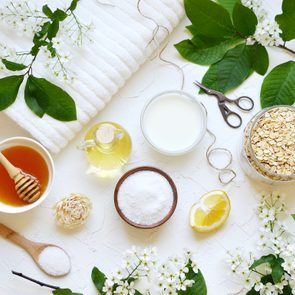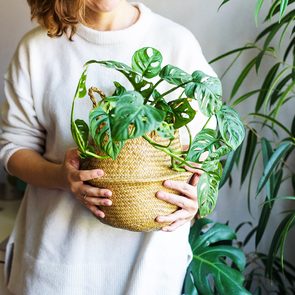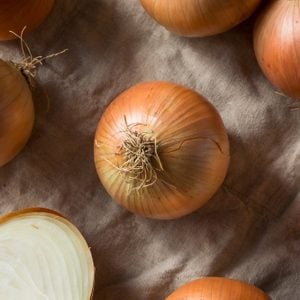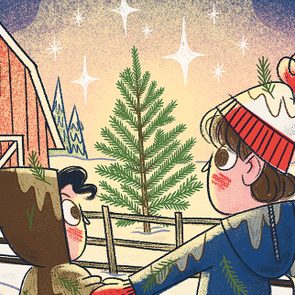Life with arthritis isn’t exactly a bowl of cherries—affecting one in five Canadians, it’s a leading cause of chronic pain and disability. Medications can help, but come with possible side effects. Enter the sour cherry—also known as prunus cerasus—a crimson red tree berry that’s supposedly bursting with naturally healing juice. Could drinking a couple of glasses a day of this suddenly trendy elixir relieve joint pain? We shook the (cherry) tree to find out the evidence.
Cherry Juice Benefits
Aside from being delicious baked into pies, sour cherries are rich in anthocyanins, the molecules of blue-red pigment that give the fruit their rich colour. Also found in blueberries, pomegranates and purple cauliflower, anthocyanins are a type of flavonoid, a beneficial plant compound with antioxidant properties. This means they protect your body’s cells against free radicals, potentially harmful molecules that contribute to heart disease, cancer, arthritis and other illnesses. Excessive levels of free radicals—which can be caused by too much sugar, fat, alcohol, or exposure to environmental pollutants—create an imbalance called oxidative stress, which causes the inflammation that worsens osteoarthritis and other diseases.
Research supports the idea that a diet rich in antioxidants can prevent and counteract this inflammation. Consuming plenty of fruits, vegetables, and whole grains—sources of free radical-fighting nutrients like vitamins C and E, carotenoids, selenium, zinc, and phenolic compounds (including anthocyanins)—is associated with greater protection from a range of aging-related diseases.
Cherry Juice for Arthritis Pain
When it comes to arthritis, the first line of defense against arthritis pain has traditionally been over-the-counter pain relievers like acetaminophen and non-steroidal anti-inflammatories (NSAIDs), but the latter especially have been associated with serious side effects, such as gastrointestinal bleeding and ulcers. Luckily, research into non-pharmaceutical therapies is gaining in popularity.
Although no large-scale studies have yet been able to confirm the benefit of antioxidants like anthocyanins, several small but promising studies have pointed to cherry juice as an effective inflammation reducer and pain reliever. In 2003, researchers at Johns Hopkins University found that rats that had been artificially induced with arthritis showed less signs of pain and inflammation after being fed anthocyanins extracted from tart cherries, compared to a control group fed with saline. In 2012, researchers at Oregon Health & Science University had a group of 20 women aged 40 to 70, all suffering from inflammatory osteoarthritis, drink about 20 ounces of tart cherry juice a day. After three weeks, their blood showed a 14 per cent reduction in C-reactive protein (CRP), a biomarker of inflammation, compared to a placebo control group, and reported lower levels of arthritis pain. A similar study published in Osteoarthritis and Cartilage in 2013 demonstrated a 23 per cent reduction in CRP.
Additional Cherry Juice Benefits
As it turns out, arthritis relief may not be the only reason to wash down your breakfast with a glass of cherry juice. Containing plenty of potassium, an electrolyte that aids muscle function, tart cherry juice is also an excellent post-workout recovery drink, helping to reduce muscle pain and stiffness.
The flavonoids in cherry juice are also thought to be immune modulators, meaning they can potentially ease the symptoms of chronic inflammatory bowel disease, Crohn’s, and ulcerative colitis. Tart cherry anthocyanins also slowed the growth of cancer cells in a study on colon cancer.
Cherry juice—whether tart or sweet—also contains two sleep-inducing chemicals, melatonin and tryptophan, and drinking one cup twice a day for two weeks led to longer and better sleep for older adults who suffer from insomnia, according to one study. The same amount of juice also seemed to improve cognitive function in seniors after 12 weeks of use, leading to higher scores on memory tests.
Thinking of adding some tart cherry to your day? Make sure you buy the kind with no sugar added, and avoid “cocktails” that contain sweeteners and preservatives. Before long, you’ll be embracing its sour kick—and hopefully putting a little more spring in your step.
Now that you’re familiar with these cherry juice benefits, find out if shark cartilage really helps with arthritis.

With the COVID-19 pandemic resulting in international travel bans across the world for most of 2020 and 2021, we decided to travel somewhere within Canada. My husband, Chris and I have been to Alberta and British Columbia in the past and we love the mountains, so any chance we get to go back, we are there! As luck would have it, we had an opportunity to visit Bighorn Meadows Resort, in Radium Hot Springs, B.C., in the first week of December 2021. This was our first trip to Radium Hot Springs—a small town nestled in the Rocky Mountain Trench between the western range of the Canadian Rockies and the Purcell Mountains—so we did not know what to expect.

The condo we booked had space for six, so we simply had to bring some family with us to enjoy this opportunity. My sister and her husband—Pat and Lorne—are retired, so they were able to make it on such short notice, while my daughter and her boyfriend—Hunter and Cody—were able to join us for the last part of the trip.

We flew to Calgary, rented a car, loaded up with groceries and then did the three-hour drive to Radium Hot Springs. Normally I would not want to tackle such a long drive after flying, but our route through the mountains was so scenic and enjoyable, at least for the passengers. My poor husband got stuck with all the driving, so kudos to him for being such a good sport.

A Week at Bighorn Meadows Resort
We were very impressed with the resort itself; it was such a lovely place to make our home base for the week. My sister and I had done research before we left to see what types of activities we could do during our stay. We compiled a list of hiking trails that we wanted to check out; visiting the hot springs was also high on our list. During that week, we were able to get to the hiking trails within walking distance of the resort; the other trails we did were only a short drive away.

I was also anxious to see and photograph the bighorn sheep, but when we didn’t spot any the first day, we asked a local about the best place to find them. As it turns out, we just had to be patient: they regularly walk all through the town. There are even flashing lights on the road to slow motorists down for the safety of the sheep.
Rut season was just ending, so although we did see some rams head-butting, for the most part, they were pretty calm. One morning, a bighorn sheep walked in front of our window at the resort while we were having breakfast; it was such a thrill to watch.

When my daughter and her boyfriend arrived at the Calgary airport, my husband offered to pick them up. My brother-in-law went with him—I think they were looking for a day off from the hiking! My sister and I asked them to drop us off in Banff along the way so we could hike the beautiful, picturesque town that we all love so much, then the whole gang later enjoyed a meal there before we headed back to our resort. A snowstorm was coming and we wanted to stay ahead of it, as falling snow could make the drive a little tricky.

Over the next few days, we hiked, soaked in the hot springs and played games in the evening. The weather was perfect with the sun shining bright, allowing for great photo opportunities. Even when passing by a small creek, the way the sun hit it was so photogenic that we had to stop to capture the shot.

At the end of our week, another snow storm was set to roll in. We overheard some locals talking about the possibility of closing the road—the only way back to Calgary—so we packed up and left extra early to make sure we could get to the airport on time. The trip was amazing and we’ll definitely visit again.
Now that you’ve added Bighorn Meadows Resort to your bucket list, check out the best winter hiking trail in every province.
If you’re a light blond or redhead
We’ll be blunt: light blonds and redheads have a higher risk of developing skin cancer. This is problematic because of the skin cancer itself, but also because light blonds and redheads tend to have a lower pain tolerance. “They will have a more difficult time when it comes to pain from laser procedures used to reverse sun damage and pre-cancerous lesions,” explains Dr. Dusan Sajic, a board-certified dermatologist in the United States and Canada who also earned his PhD in molecular immunology virology and inflammation. “This is especially true for a procedure called photodynamic therapy,” Dr. Sajic explains. “Not only is it more painful for these individuals, but it will also lead to much more of a severe reaction.”
Bottom line? Wear sunscreen every day (yes, even in the winter) and follow the Skin Cancer Foundation’s skin cancer prevention tips, such as covering up with UPF clothing, seeking shade during midday, and seeing your dermatologist for regular skin exams.
In addition, a study showed a correlation between decreased pigmentation in hair and an increased risk of Parkinson’s disease. This applies to both redheads and blonds with lighter hair. “People with lighter hair colour have a higher chance of developing Parkinson’s disease,” Dr. Sajic says, “but more studies are needed. In the meantime, report any neurological problems to your doctor as early detection is key.”
Good news for redheads!
There is some good news for redheads. “A Finnish study showed redheads have a lower risk of prostate cancer,” says Dr. Carmen Castilla, a New York City-based, board-certified dermatologist. “However the precise reason for this benefit is unknown.”
If your hair turned grey prematurely
First, let’s get clear of what “premature” means in this context. If your hair goes grey before you’re 30 (if you’re Black) or before you’re 20 (if you’re white), that is considered a premature loss of pigment. You may feel too young to have grey hair in your forties, but that’s a typical time for it to start transitioning.
“Genetics play a large role in when your hair turns grey,” explains Dr. Castilla. “However, premature grey hair can have underlying metabolic causes. Both B12 deficiency and thyroid dysfunction can cause premature grey hair.”
Dr. Reid Maclellan, Adjunct Professor of Plastic Surgery at both Harvard Medical School and Boston Children’s Hospital, points to the research. “When you start greying young, it could possibly mean there are certain health issues associated with the greying, like a B12 deficiency, thyroid disease, vitiligo, and alopecia areata.” Dr. Maclellan says, “If you’re noticing greying at a young age, it’s worth seeing a dermatologist, hair specialist, or another certified expert if it’s of concern.”
Another thing is if your hair goes white or grey when you’re young, but it’s restricted to a streak. “If the white hair is in a streak on their forehead, they have a higher chance of neurological disorders and should talk to their doctor about this,” Dr. Sajic says. A “white forelock” is technically known as poliosis, and includes white eyebrows and eyelashes.
Brunettes
For brunettes, hair loss is a problem to look out for. According to Cleveland Clinic, hair loss isn’t just for men, and “50 per cent of women will experience noticeable hair loss.” Brunettes are more likely to show signs of baldness both because of genetics and because sparse patches are more noticeable with darker hair. Cleveland Clinic recommends increasing iron through iron-rich foods such as spinach, broccoli, peas, tofu and iron-rich meats like beef, lamb, and oats.
Dyed hair colour
Because dyed hair can be any colour, we can’t generalize about conditions that could be connected to a hair colour that’s not your own. That said, those who dye their hair are at a greater risk of developing cancer, and if you dye your hair darker shades of brown or black you might want to think again.
“While there are many non-toxic hair dyes on the market, there are other hair dyes that contain chemicals and possible carcinogens in their formulations,” explains Dr. Maclellan. “Lifestyle choices including certain hair dyes in studies have been linked to a greater chance of developing Non-Hodgkin’s lymphoma (NHL). People with a family history of NHL should pay extra attention to this. People who use darker hair dye, especially over time, could run the increased risk of developing NHL since there’s a higher amount of chemicals used to turn hair darker.”
Those who bleach their hair to achieve a lighter shade may not have the same genetic risks that blonds and redheads have, but there are risks associated with repeated use of hydrogen peroxide and other bleaching agents.
Next, discover the sneaky reasons your hair is falling out.

Memories of My 1956 VW Beetle
When I was stationed at a Canadian Air Force base in Winnipeg in 1963 as a meteorological observer (Met Ob), I bought a 1956 VW Beetle. It had no gas gauge, but after a while, I noticed a small groove on the inside of the driver’s door that had a small pin inside it. Eventually, to my delight, I noticed that when I added gas to the tank, the pin changed position to the right—so I knew when I had to fill it up. The last owner must have installed it, because there wasn’t anything indicating what it was.
The heating system was also hard to figure out; I either froze or sweated before getting to know how it worked. My VW also had a gas pedal that looked like a coiled doorstop. It was awkward to use, especially with high heels, so I had someone install a makeshift one out of a piece of wood.
At the end of March ’64, my RCAF contract was complete, so I left for Sept-Iles, Quebec—where my fiancé had been stationed—to get married. He met me in Montreal and we set off on the 600-mile trek to Sept-Iles in my Bug. There had been a very big storm and the roads were barely open. We made it past Baie-Comeau, about 70 miles from our destination, when we went into a skid, blocking the road as we came to a stop. A car with four young men soon appeared. With a man at each corner, they picked up the Beetle—with us still inside—and put it back down, now facing the right direction.
Continuing to Sept-Iles, I kept seeing small road signs that read “Cahots.” The road wasn’t paved and had a lot of potholes. When I hit a big one and my fiancé told me to be careful, I said I didn’t see them coming. He asked, “What do you think ‘cahots’ means?” When he told me it was the French word for “bumps,” I said I thought it was the name of a small village coming up!
We kept that VW Beetle for a couple of years and even bought two more in the ’70s.
Next, check out one man’s fond memories of his 1963 VW Beetle.

Home Remedies for Indigestion Worth Trying
Ginger
Ginger is famous for settling stomach upset and improving digestion. As a home remedy for indigestion, you have three options: Take a ginger supplement (preferably with meals), eat a few pieces of candied ginger as needed, or brew up a cup of ginger tea. (Check out more healing herbs and spices.)
Chamomile
Chamomile is an age-old home remedy for indigestion. It calms the stomach and soothes spasms in the intestinal tract. Drink a few cups of chamomile tea throughout the day.
Peppermint
If you prefer a little zing, pamper yourself with peppermint. The plant’s oil soothes intestinal muscle spasms and helps relieve nausea. Like ginger and chamomile, the easiest (and tastiest) way to enjoy the potential healing powers of peppermint is by brewing a steaming cup of peppermint tea.
Fennel and Caraway
Chew and swallow a spoonful of fennel or caraway seeds when you’re having indigestion. These seeds contain oils that soothe spasms in the gut, relieve nausea, and help control flatulence. Fennel can also help prevent indigestion if taken right after a spicy meal—one of the reasons Indian restaurants often set out dishes of fennel seeds for customers to enjoy.
Licorice
No, we’re not talking about the black licorice from the candy aisle. Most of the health benefits of licorice are exclusive to deglycyrrhizinated licorice, or DGL, sold in health food stores. This product soothes stomach upset and indigestion by coating the lining of the stomach.
Hot Water
Some people claim that drinking a plain old cup of hot water eases indigestion. Warm ginger ale, lemon-lime soda, or flat cola are also said to soothe an upset stomach.
Apple Cider Vinegar
A sour solution: try drinking a teaspoon of apple cider vinegar diluted in a half-cup of water. It will help you digest the food if you don’t have enough acid in your stomach. (You can add a little honey to sweeten the taste.) This works well after a large meal, so long as you avoid these apple cider vinegar mistakes.
Baking Soda
Stir a teaspoon of baking soda into a glass of water and drink it. If your stomach is too acidic, this solution neutralizes stomach acid and also helps relieve painful gas.
Now that you know these home remedies for indigestion, check out the sneaky reasons you’re always bloated.
Poinsettias are popular both as gifts and festive decor, but novice and experienced gardeners alike can use some tips on how to care for poinsettias over the holidays—and beyond. Check out these pro poinsettia care tips and advice for other popular holiday houseplants.
How to Care For Poinsettias
Many people simply keep their poinsettias around until they’ve lost their coloured leaves, and then throw them out. But with a little care, poinsettias can be brought back to bloom year after year.
- Poinsettias are photosensitive, and bloom only when they receive at least 12-14 hours of complete darkness each day. To keep them blooming year after year, you just need to mimic their yearly growth cycle.
- For now, keep your potted poinsettia in a bright sunny window and water well when the soil feels dry. In spring, cut it back and transplant it to a bigger pot. You can move it outside for the summer months if you like. Next fall, begin ensuring the plant receives the necessary 12-14 hours of darkness by keeping it in a room with no artificial light, or placing a box over it at night. The coloured leaves and blooms should appear in about eight weeks.
- If you live in zone 9 or higher, skip all the complications and just try growing poinsettias outside! Plant them in well-drained soil where they will receive plenty of sun, but avoid areas that have nighttime lighting, like streetlights or solar lighting. This will keep them from blooming. In warm climates, the tiny yellow flowers will even draw butterflies in winter!
Christmas cactus
Like poinsettias, Christmas cactus knows it’s time to bloom when they start receiving 12-14 hours of complete darkness each night. Water sparingly throughout the year and keep in bright indirect light.
- When fall arrives, follow the same procedure as with poinsettias, keeping them in a room with no artificial light or placing a box over them at night.
- You can try growing Christmas cactus outdoors in warmer climates, but this plant is from the coastal mountains of Brazil and has very specific growing conditions. You’ll do better keeping it in a pot so you can monitor and adjust the conditions more easily.
Amaryllis
Because your amaryllis bulb was likely “forced” to bloom in time for Christmas, especially if you received one in full bloom, it may take a few years before this warm-climate bulb is ready to flower again. Don’t give up, though! Amaryllis are pretty easy to care for in the off-season, and their spectacular blooms make it worth your effort when they return.
- Again, if you live in zone 9 or higher, just plant these outdoors. Once the flowers have died, cut the stalks back and plant outside. They do best in part shade with bright filtered light, but can withstand a variety of growing conditions as long as the soil is well-drained. Give them plenty of water all summer to encourage new growth, but taper off in the fall. Look for bloom stalks to appear by March or so. (Amaryllis natural bloom time is in the late winter or early spring, so they will not bloom for Christmas in the years ahead.) Like other bulbs, these will grow offsets (bulblets) that can be divided and planted elsewhere.
- In cooler zones where you must keep your amaryllis in a pot indoors, your goal will be to mimic the natural life cycle, including water and light.
Paperwhites and other forced bulbs
Unfortunately, these bulbs are unlikely to bloom again next year. They have been “forced” by the growers to bloom quickly in the holiday season, and have used up all their stored reserves. If simply throwing them away is just too hard for you, you can try planting them outdoors to see what happens, but don’t count on them returning.
Check out more festive Christmas flowers (that aren’t poinsettias).
It’s the most polarizing problem in poultry—should you wash your chicken before cooking it? Food health and safety professionals are advising against this practice, as it can increase the spread of bacteria and the risk of cross-contamination. Carefully handling your raw chicken during preparation is key to avoid food poisoning.
Most people who clean their chickens think they’re washing germs or sliminess from the chicken. And while they’re correct in assuming that raw chicken is often teeming with bacteria, such as campylobacter or salmonella, washing it with water does nothing to combat this. In fact, washing your chicken actually worsens this problem, according to the Centers for Disease Control and Prevention, because the running and splashing water can spread bacteria around sinks, countertops, and even your clothing. The USDA maintains that the only sure way to eliminate bacteria is to cook chicken to the proper temperature, and these rules extend to other types of meat and fish as well. The minimum temperature of cooked chicken should be 165° Fahrenheit (74° Celsius), and you can find the temperature for other types of meat in this table as well.
Even professional chefs have been divided on this issue. Julia Child was a staunch supporter of washing chicken, while Ina Garten has reinforced that there is no need to wash it or other meats. Garten’s side has the science to back it, and, the potential hazards of washing chicken notwithstanding, there’s really no reason to do it other than attachment to long-cultivated habits.
If you remain loyal to washing your chicken, however, as Drexel University food safety researcher Jennifer Quinlan told NPR, try not washing it at least once to see if you can really notice a difference. If sliminess is an issue, try patting the chicken down with a paper towel. Should you decide to continue your washing habit, you’ll need to take measures to properly disinfect any surfaces the liquid or splashing may have come into contact with to prevent cross-contamination, and wash your hands thoroughly after touching raw meat or any food or tool that has come into contact with it. The careful handling and preparation of raw poultry is essential to staying healthy.
Next, find out which expiration dates you should never ignore.
For some, putting up Christmas decorations is yet another holiday chore. But for the Pascucci family, stringing lights and decorating the yard of their home in Bethpage, New York, was always a time of celebration.
Starting in early November, Anthony Pascucci, the family patriarch, and his older sister, Connie, would visit local stores to check out new decorations and to dream up their vision for that year’s extravaganza.
Anthony’s son, Anthony Jr., and daughter, Sara, shared the home, and they pitched in as well. Anthony Jr. helped with the wiring, while Sara hung ornaments on the tree inside the house, playing “White Christmas” over and over to keep everyone in the spirit.
In 2020, as in every other year, Anthony Sr. strung colourful lights all around their roof until it looked as if sparkles were dripping onto the porch. On the front lawn, he inflated a large Frosty the Snowman and a Rudolph with a glowing red nose. The whole place looked like a scene from a Christmas storybook.

Anthony Sr., 60, had outdone himself, as if the brightness of the lights could counter some of the darkness of the Covid-19 pandemic. “It was just such a rough year that he tried his best to make it extra special,” Sara says.
On Christmas Eve, the whole house twinkled with lights, and gifts were piled under the tree. Everyone was looking forward to spending Christmas Day together as a family.
Then Connie got a call: someone she worked with had tested positive for Covid. Though Connie didn’t have any symptoms, she decided to get tested right away. Her rapid test came back positive.
Anthony Sr., Anthony Jr. and Sara decided they should get tested too. When their results came back, they all learned that they also had Covid. Sadly, they agreed their Christmas celebration would have to be cancelled.
At first, everyone’s symptoms seemed to be manageable. But right after the new year, on January 4, Anthony Sr. started having trouble breathing. Anthony Jr. took him to the hospital, where he was admitted.
Five days later, Connie began feeling weak and wouldn’t eat. Sara called an ambulance, but Connie died before they got to the hospital. Less than a week later, Anthony Sr. passed away.
Sara says the following weeks were the worst of her life. Grief left her doubled over in pain. On top of that, “we were still recovering from Covid ourselves,” she says.
In addition to helping to plan funerals for her father and her aunt, Sara had to figure out the mortgage payments and transfer the utility bills. And perhaps hardest of all, she had to try to explain to her 18-month-old son, Robbie, the concept of death. It was almost too much to take.
But when she pulled up to the house at the end of another long day, the twinkling Christmas lights brought her a spark of joy. “It made us happy to see them,” she says.
The lights were one of the last mementos Sara and Anthony Jr. had of their beloved family members when they were still alive and healthy. Taking them down felt like a final act of closure she and her brother weren’t ready to take. So they kept them up.

One day in February, Sara received a typed note in the mail. “Take your Christmas lights down! It’s Valentine’s Day!!!” the unsigned letter read.
Sara looked at the paper in shock. Then she got angry. “We were already dealing with so much,” she says.
Sara could have bottled up that anger, but she decided to write about it instead. “I wanted to remind people that we all had a tough year. We all have been through so much and people should be a little more caring toward each other,” she says.
She shared the letter on Facebook, adding a note of her own: “If you know of a person who would do something so insensitive like this, please pass along my message.” She ended the post with the following: “Be kind to people because you never know what they are going through.”
Sara’s inbox quickly filled with words of support. A local news station learned what had happened and ran a segment about it. People started sending Sara letters and Facebook messages about how they’d lost relatives, too, and how it was especially tough to lose loved ones around the holidays.
The prevailing sentiment from friends old and new: keep the Christmas lights up.
“I know what it feels like to lose someone and not want to put their things away. It’s very hard,” one man told her when he stopped by with a bouquet of roses. Thoughtful neighbours sent meals and cards.
“I wasn’t expecting that much support,” Sara says. “But having it helped us get through a rough time, just knowing that people could relate.”
And then something strange began to happen. Sara was driving back from work one day when she noticed that Christmas lights and decorations were appearing—or reappearing—on her neighbours’ houses.
The mystery had a sweet explanation: her neighbours had gotten together and decided, collectively, to hang their lights back up in honour of Anthony Sr. and Connie.

“I couldn’t believe someone would send her this letter,” neighbour Karen McGuggart told The Washington Post. “Losing her wonderful dad, whom all the neighbours loved, and her beautiful aunt, who was always smiling, is such a tragedy. We were heartbroken.”
The support didn’t stop with the decorations. When the man formerly named Frank Pascuzzi—who legally changed his name to Santa Claus—saw Sara’s story on TV, he decided to take his Santa suit out of seasonal retirement. (He spends the holidays dressing up as Santa and making appearances for local organizations.)
On Valentine’s Day, Claus rode down Sara and Anthony Jr.’s street in a car parade he had helped organize. One of the first cars in line blasted “Frosty the Snowman” while some 60 others followed in vehicles decked out with flashing Christmas lights.
“We wanted them to see that the community was behind them,” Claus says.
Sara, her brother and her son stood outside their house and waved to the passing crowd. It had snowed the night before, so the neighbourhood was covered with a dusting of white powder. It was as if all of the world were conspiring to make sure Sara and her family had a proper Christmas. “We got a little bit of joy back that night,” Sara says.
She never learned the identity of the person who sent the note. But for the Pascucci family, that one mean-spirited act was far outweighed by so many more acts of kindness. “The good does outweigh the bad and most people have good hearts,” Sara says.
A few weeks after the surprise Valentine’s Day Christmas parade, Sara and Anthony Jr. finally took down their holiday decorations. Sara said it was hard—“but not as hard as I think it would have been if we didn’t experience all that support and love.”
The family plans to keep putting on a bright, colourful Christmas. “We aren’t going to make it a sad holiday. We will keep the tradition going,” Sara says.
And if they make their display bright enough, she believes her dad and aunt might even be able to see it from heaven.
Here are more good news stories that’ll brighten your day.
Hosting Christmas dinner is a big job. A rite of passage, really. I’m in my early forties and, to this day, I have yet to oversee the cooking of the Yuletide turkey. I assume it’s because I don’t have children, as hosting in my family usually falls to the households still getting visits from Santa. Either that or they think I’m a terrible cook.
I am lucky to have a close relationship with my two sisters. Growing up, we tended to seamlessly correspond with birth-order stereotypes. The eldest, Kate, was a responsible, bossy perfectionist. I was the people-pleasing, attention-seeking middle child. And Kerry, the baby, was charming, sensitive and entirely lacking in self-discipline. We were, as much as I hate to admit it, clichés.
Kate wrapped gifts in brown paper, with perfectly tied bows on top, and diligently passed around hors d’oeuvres as people opened their presents. I was unnecessarily effusive about the tube socks and plastic earrings I received from a great aunt: “Wow! They’re for my feet! And it doesn’t matter that I don’t have my ears pierced, I can do that before dessert if you like!” And Kerry would be gushed over by our grandmother because, apparently, she was a genius for knowing how to dress her new Barbie.
As we’ve aged and matured, I like to think our predetermined traits have become more nuanced.
When I was 25, there was a seismic shift as our family was forced to redefine itself. Our dad, who was a beloved, larger than life figure in our world, died from cancer. The hole he left was palpable. Who would become our new sage elder? Who would sit opposite my mother at the table? When our extended family inevitably got on each other’s nerves at the next holiday gathering, who would lighten the mood?
Newly married Kate and her husband, Shane, lived in a split-level house in our hometown of Peterborough, Ontario. A year after our father’s passing, our family’s Martha Stewart volunteered to host her first Christmas dinner at the ripe old age of 27. There would be 12 mouths to feed, our extended family included. The challenge was on!
As a 1980s parent, my mom was a casserole-and-jelly-mould type. At Christmas, our candles were battery operated, our turkey was a pre-stuffed frozen Butterball and our tree looked like the bobble department in Sears had thrown up on it. The holiday was homey and carb-filled.
My sister Kate, on the other hand, prepared for her inaugural hosting sortie by making wreaths, folding napkin swans and decorating her tree with colour-coordinated fabric, tinsel and tiny white lights. And the pièce de résistance: a fresh, not-even-remotely-Butterball turkey.
On December 25, 2005, we gathered at Kate’s and opened our stockings while sipping wine and nibbling on appetizers that looked like they’d been plucked from a magazine spread. My dad, who had a mischievous sense of humour, was famous for his joke gifts, a ritual we wanted to continue after his death. Kerry received a sparkly wand so she could relive her stint in the grade-school baton-twirling club. Mom got a pair of full-bottomed underwear with “Granny Panties” splashed across the derrière. Shane was gifted a bag of BBQ flavoured crickets, because it was just gross enough to be funny.
We were proud of ourselves for carrying on Dad’s tradition, despite our grief. Still, the clock was ticking, bellies were grumbling and best behaviours were starting to fray.
Cooking a turkey is more complicated than one might think. It includes brining and basting and, apparently, math. A bird requires five hours of thawing per pound, and then 13 minutes of cooking per pound after that. This was all too cumbersome for our mother, so when Butterball invented the pre-stuffed, cook-from-frozen fowl, she thought she’d died and gone to Christmas-dinner heaven.
Having never seen our mother cook anything but Butterball, my sister, days earlier, had put her fresh turkey into the freezer to keep it, well, fresh. When I entered the kitchen at 7:30 p.m. for an ETA on the gravy boat, I found Kate in a state of panic. It was a perfect storm: the oven had stopped working and the turkey was still rock solid. She’d been duped by both General Electric and the culinary shortcomings of our domestically challenged mother.
“Everything is ruined! I didn’t know a real turkey needed to be defrosted!” she cried, looking defeated as her oven mitts hung off the ends of her arms like sagging lobster claws. Ever the supportive younger sister, I burst into laughter, grabbed my boots and a shovel and cut a path through the heavy snow to the barbecue. We transferred the bird to the back deck, uncorked more wine and headed into the den filled with starving aunts to break the news.
While the turkey was on the grill, Kerry twirled her baton to the Rocky theme song, my mom donned her new granny panties over her dress pants and Shane passed around handfuls of BBQ crickets—which go surprisingly well with a chilled chardonnay.
At midnight, the bird was ready to be carved, the side dishes were microwaved and the pleasantly pickled guests sat down to devour Kate’s holiday repast. A frozen bird and a broken oven forced us to let go of our usual expectations as to how Christmas should go.
Subsequently, we’d all been freed from our assigned roles. We were all allowed to just…be. No one made passive-aggressive comments about the consistency of the mashed potatoes, no one was told to take their elbows off the table and no one had a bad time. It turns out that hosting Christmas dinner wasn’t so hard after all. It just required everything to go perfectly wrong, so it could be perfectly right.
Next, check out 10 funny Christmas stories shared by our readers.
It was 1994, and at age nine I was way too old to still believe in Santa Claus. And yet, blindsided by Julia’s casual response to my Santa enthusiasm that year, I doubled down and branded Julia a liar. After all, movies had taught me that Christmas magic outweighed what I’d already begun suspecting as fact. What did she know, anyway? I had it on good authority that one year, my dad heard sleigh bells and hoofs on our roofs himself.
But by Christmas Eve, I was consumed by the feeling that Julia wasn’t wrong; that the concept of Saint Nick didn’t really make sense, and that there was no way the mall Santa I was staring at while standing next to my parents could possibly make it to the North Pole and back to Cambridge, Ontario, by nightfall.

My dad headed off to buy a new suit for the holidays, and my mom led me to Shoppers Drug Mart. I gazed at the chocolate while analyzing the Christmas music playing over the store speakers. With each mention of Santa Claus or red-nosed reindeer I started to feel warm. Sick. Like I’d stumbled upon a truth I was never meant to know, and would be forever cursed by its effects. I silently followed my mom up to the register, and felt the words rising, knowing there’d be no turning back once they tumbled out.
“Mom,” I said, as the cashier rang us through. “Are you and Dad Santa?”
The cashier began scanning items faster and faster, her widened eyes glued to the digital display. I didn’t wait for a response before pressing on.
“Is Santa real?”
The cashier was moving at record speed, desperate to get me and my impending meltdown out and away.
My mother, forever honest, simply looked at me.
“Well, sweetie, what do you think?”
That was enough. I wasn’t stupid. Neither of us was. So as if I were Willem Dafoe in Platoon, experiencing a slow death at the hands of his enemies, I crumbled under my new cold, cruel reality, devoid of magic, and I wailed for my lost innocence. Which is what I was still doing as we walked across the concourse to Tip Top to meet my dad, who was revelling in his new blazer.
“What do you guys think—” he started to ask, the grin on his face vanishing as he saw me in tears. “Oh my God, what now?” My mom gave a simple, grave answer: “She knows.”
“Knows what?!”
“SANTA’S NOT REAL!” I wept among the pleated slacks, button-ups and sensible sports coats, all while trying to hide my outburst from the salesman whose biggest concern was now whether my dad would be going through with his purchase. (He did.) By the time we made it to the car, I was crying quietly, gazing out the window and vowing never to forget the pain their deception had caused.
At home, I sat miserably on the living room floor, reconciling with the fact that our Christmas tree was an obvious farce; an empty symbol that was no longer a testament to Santa’s generosity. I bet my parents had even eaten the cookies and milk I’d left under it simply because they could.
“You know,” my mom said as my dad tended to his new tweed treasure, “I know this is hard, but now you’ve got to help keep the magic alive for your little cousin. You get to help make her Christmases feel extra special.”
This made me perk up. Suddenly, I understood the true meaning of Christmas: not presents or folklore or the man in red, but power. The power to give and the power to take away. As my first act of this newfound adulthood, I agreed never to ruin Santa Claus for anyone. But I also vowed to keep tabs on my enemies—like Julia who tried to strip me of the magic of Christmas and would always be on my naughty list.
A list even more powerful than Santa Claus’s.
Next, check out 10 funny Christmas stories shared by our readers.

























